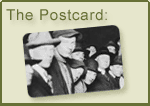|
|||||||||||||||
|
The Story
Resources
Background
|
By Chris Julin and Stephanie Hemphill
June 2001

|
|
Melissa Taylor is a member of the Clayton-Jackson-McGhie Memorial Committee. She recalled seeing the photo of the lynching for the first time,when she was in high school. Listen to her story. (MPR Photo/Stephanie Hemphill) |
"Because to not discuss it leaves the ignorance there to fester. That is the reason for that type of thing happening - ignorance. And we understand now that if something happens, the best is to bring it out, examine it, and see what it's worth," says Kennedy.
Everyone on the memorial committee wants more discussion of the lynching, but some committee members worry about the way people discuss it. Melissa Taylor says people now talk about the lynching as a disturbing piece of Duluth past. But she says it's dangerous to think the lynching is just history.
"We don't actually hang men from lampposts, but all the undercurrent of emotion and hate and fear that drove this community to do that in 1920 still exists," says Taylor.
When people look at the photograph of the lynching, they sometimes say, "How could that happen in Duluth? How could that happen at all?" Melissa Taylor has some idea. She's lived in Duluth all her life, but she says she feels like an outsider. She says people stare at her everywhere she goes. She's not willing to call it "hate," but it's hostility, as if there's an uneasy truce between the races.
For her, and for many other black people, there's no mystery about how it could happen - how a mob could drag three men from a jail, hang them in the middle of downtown, and snap a picture.
Postcard From A Lynching was written and produced by Minnesota Public Radio's Chris Julin and Stephanie Hemphill.
Thanks to Pat Maus at the Northeast Minnesota Historical Center.

